The threat of winter weather pushed right up to the last frost date for my area this year. Add in my hectic schedule the past few weeks and the result is a late start on my spring garden, and some corners looking to be cut.These colorful lettuce varieties would normally be carefully planned and planted in their own distinct areas.This year I am deploying what I am calling a laissez-faire farming method of "mixed lettuces" saving a lot of time and proving that even lackadaisical farming sounds better in french.Seeding and watering these 9 square feet (around 100 plants) was the work of 5 minutes.I have to give a quick shout out to the oregano photo bombing the picture above (bottom and right of garden bed). This now feral oregano self seeded the area around it two years ago when I had the herb planted in this box. It is so thick and lovely year round that I am tempted to use it as a ground cover along paths.For the rest of my garden, this year I am doing a lot more grouping than normal, with all of a bed planted with spinach or radishes or edamame, allowing me to broadcast seeds and get everything started a little faster.Au revoir!
Read MorePeeking at Presents
It is the day after Christmas and I wanted to peek at a couple of presents, patiently waiting their turn in the garden.We have had a few light freezes in the Raleigh area and at least one hard freeze so far this winter so the parsnips and carrots should be busily converting the starches into sugars making them sweet and delicious.I pulled up a couple of volunteers to roast along with the leftovers for tonight's meal and am pleased with the weight they have put on in the past 2 months. Taste Test to come!
Read MoreKale Chips - Sometimes a Matter of Necessity
The Scarlet Kale in my counter top hydroponic system has been growing by leaps and bounds to the point that they are overshadowing the slower paced cilantro and parsley starts.I needed to trim some leaves to let more light down to the smaller plants in the middle and a great excuse for kale chips.I use my hands to toss the rough chopped leaves with a little olive oil then sprinkle with salt (cayenne or any other spice you would like to add) and toss again.Cook at 350 on a parchment lined pan for until crispy and paper like, apx 10 minutes.I like to let mine cool on a rack for good air circulation and while I haven't done side by side experiments, I think it keeps them crispier.
Read MoreAutumn Recess
Autumn has arrived in North Carolina, bringing with it the final harvest of bell peppers, roma tomatoes and serrano peppers.The herb garden has brushed off the first few light freezes and stands ready to make meals fragrant and savory for months to come. I am confident that the thyme, oregano and sage will over winter well and hope that the french tarragon and parsley will also.Parsley is such a staple of fall and winter dishes that I have more growing on my deck. I have been poaching from the deck parsley for a few weeks thinking that it would not handle the frosts as well, but so far it is also doing wonderfully.In previous years I have repeatedly removed pine needles from the garden beds only to replace it with a different mulch. This year I have come to my senses and am embracing the pine trees taking care of mulching for me.Collards, carrots, cabbage and parsnips are tucked into their naturally (and effortlessly) mulched beds.The fall planting of sugar snap peas has been supplying tender pea shoots and now has peas forming as well.The hydroponic herbs were changed over 10 days ago to the varieties I know and love to cook with and are already doing quite well. I am growing 2 plantings each of my favorite basils and cilantros, 3 of the flat leaf parsley and just for fun I am trying to grow 2 red kales hydroponically.With the Super Bowl and attendant tomato starts almost 2 months away, this cozy, fall garden that is mostly taking care of itself feels like a recess.
Read MoreAero Garden Update - Day 46
Day 46 of the prepackaged herb pack that came with my AeroBount and I have excellent basil growth, both genovese and thai. The mint was just starting to grow and the cilantro, parsley and chives never really took off. The genovese basil, while in the same family, is not the basil I usually grow. I do not know if it is a function of the variety or of the hydroponics but it bruises extremely easy and blackens quickly on warm dishes.My Baker Creek order came in last week with seeds for my hydroponic herbs and counter top microgreens so I decided to ditch the prepackaged herbs and start my own this weekend.My aero garden has space for 9 pods so I planted 2 of each except for the parsley that I planted 3 pods of because fall stews + parsley = YUM!
Read MoreAeroGarden - Day 18
A quick update on the AeroGarden:Day 18, I topped off the water a couple of days ago when it was time to the second application of nutrients.The basils are doing great and the mint is beginning to peek out...otherwise, not much happening in the other 5 starter sponges. I have some replacement starter sponges I purchased with the garden as well as some fresh herb seeds on their way from Baker Creek. I think a replant with new seed will get the empty spots going.
Read MoreCollards - From Garden to Table
This year I grew the heirloom collards called Georgia Southern Creole, a pre-1880 southern variety that has done quite well overall.Growing organically means that some of the leaves were ventilated by a mid-summer cross-striped cabbage worm invasion (treated with BT) and that I am currently trying to diminish the whitefly population with a hose and organic soap. Having no pests is not an option, keeping them in check is the goal.No matter how your collards were grown, its always best to give them a good soak and cleaning before cooking and the easiest way to do that is to fill up a sink with enough water to cover then swish, swirl and agitate, drain and repeat.I have tried a number of collards recipes and variations since moving to the south 3 years ago and this is the one I like best so far:Braised Collards:
1 lb of washed collards, stems still on
1 TBS oil (I use an extra virgin olive that is good for cooking, but any vegetable oil should work)
3 slices of thick sliced bacon, cut into lardons
1/2 tsp red pepper flakes (more or less depending on preference)
1 medium onion, chopped
1 TBS red wine vinegar
6 TBS stock (chicken, vegetable or mushroom)
Salt to season
Remove stems from collards and stack leaves and stems separately. Finely dice the stems and set aside. Stack a few collard leaves and roll into a cigar shape and cut crosswise (chiffonade) into 3/4" pieces, repeat until all leaves are cut and set aside separate from the stems.In a large frying pan (I like to use my 10" straight walled pan) on medium-high, heat oil until hot but not smoking. Add bacon and red pepper flakes and stir until bacon begins to crisp. Add onion and diced collard stems. Cook until onions are translucent and stems have begun to soften, about 10 minutes.Add the chopped leaves one handful at a time, turning into the bacon and onion mixture after each handful before adding the next. When all of the collards have been added and turned into the mixture, salt to season. When the mixture begins to sizzle, add the red wine vinegar and use a wooden spoon to gently deglaze the pan while turning the mixture.Add your stock* and turn into mixture, cover and turn heat to low. Let cook another 10-15 minutes until greens reach desired softness. If necessary, add more stock to keep from drying out.*Note - I filter and freeze the water after I have rehydrated morels and use this to add liquid and a delicious umame component to many dishes, including this one.
Read MoreSaving (Pretty) Seed - Glass Gem Corn
My Glass Gem Corn has been happily drying above my home office and today was the day to strip the cobs and put up the kernels for popcorn and next year's planting. If you have been following my blog for any amount of time you know that I have an abundant affection for this particular varietal which translates into an excess of photos...I stripped all the multi-color cobs leaving the two almost entirely blue cobs for last.Some of the kernels will be seed for next year and some will be popcorn, but in the meantime, they are still decorating my home office.
Read MoreBig Finish - Glass Gem Corn
The Glass Gem Corn is winding down and I will have a couple more ears to harvest over the next few weeks but today was really the big finale with 4 ears harvested and two that were almost* entirely in the blue spectrum.I plan to make some popcorn from this year's harvest, but also plan to double my planting for year's crop from saved seed. This is a exponential goal/reward because for every one corn plant I plant two black eyed pea plants to nourish the corn and climb the stalk for support and I am enjoying the still growing store of homegrown black eyed peas to cook up for good luck on New Year Day and would like to have even more for New Years 2018.*the bottom right cob has a single green kernel that only makes the rest of the cob look all the more blue.
Read MoreI Can't Even - Glass Gem Corn Harvest
Yes. It is just that beautiful!
Read MoreJuly Garden Update
Under the best of circumstances July is an awkward time for the garden.Spring greens (spinach, lettuce, cilantro) still in the garden have bolted or browned, strawberries have stopped producing anything but dozens of straggly runners and asparagus has transmogrified into its less known, fuzzy small tree form. Between these only-a-mother-could-love-them beauties are the bare spaces where sugar and snow peas and pak choy have been removed but it is still too early to sow fall plants, July may be the worst time to have a garden guest.I have a garden guest coming next week.The wonderful REALTOR that patiently waited and watched while I stood in potential back yards mentally calculating full sun hours and painstakingly measuring for raised beds that were at the time, stored in a rented garage, is coming to see what I "have done with the place" and late July is the date we picked for dinner and a garden tour.This post is half garden update, half convincing myself that there are still beautiful things to be seen even in this straggly season. Here goes:The blackberries are huge and I should still have a good mix of ripe and unripe next week.I always overseed plants like basil so I can use the thinnings on meals while letting the main plants mature.There is only one butternut squash on the vine so far, but many blooms.I picked my first round of Envy edamame with only a handful left in the garden, but I had left the wonderful nitrogen fixing plants in the garden as companion plantings to everyone else.And the rest of this story is tomatoes, the beauties of summer. These are some of the Blue Cream Berries cherry tomatoes before they ripen and take on that creamy yellow color.The roma tomatoes are thick on the vine and ripening at a steady rate.A pretty average harvest day with a double handful of roma tomatoes, a couple of Mortgage Lifters, a bowlful of Hartman's Yellow Gooseberry cherry tomatoes (the most prolific and tallest of my cherry tomato plants this year) and my first Black Beauty zucchini of the year.Here's hoping she really likes tomatoes ;)
Read MoreFood With a Story - Mortgage Lifter
When was the last time you ate a tomato and considered the intrigue and controversy surrounding it's provenance?This big guy, sold by Baker Creek under the name Mortgage Lifter is almost ready to harvest and when I save the seeds after enjoying my first taste of this storied heirloom fruit, I will be thinking of the dueling stories of where it originated. A little food for thought ;)
Read MoreLast Frost Date
Last night was a low of 28 so the tomatoes were covered (again) and I am optimistic that it was the last night of freezing temps (again). This time, at least, I have the Average Last Frost Date in my corner...though average and last possible vary by over a month.I the meantime, the container garden on my deck planted with cold weather crops is just fine with or without a light frost. The beautiful colors and daily growth of of these varietals make warmer weather feel not so far away.This is my first year growing Lollo De Vino Lettuce. I had run out of room in the garden for another lettuce but it was just to pretty to resist when I ran across it so I am growing it in a container along with a volunteer cilantro. Another first year variety, the French Breakfast Radishes have sprouted. I planted Snow Peas in the container garden this year to add some height contrast to the low growing lettuce and radishes. The easy access to peas and shoots is a total bonus.Today's cold weather task is to give some overdue attention to the indoor basil garden which needs some pruning and thinning.Happy Average Last Frost Date (for Raleigh NC)!
I planted Snow Peas in the container garden this year to add some height contrast to the low growing lettuce and radishes. The easy access to peas and shoots is a total bonus.Today's cold weather task is to give some overdue attention to the indoor basil garden which needs some pruning and thinning.Happy Average Last Frost Date (for Raleigh NC)!
Paradigm Shift
I sometimes forget the prevailing notions people have related to growing food. The most common mental images seem to center around long hours of back breaking labor spent tilling, planting, hoeing and weeding.I am quickly reminded of the current thinking when I breezily say things like, "I planted 288 spinach plants today and need to do the same for lettuce tomorrow." and the person I am speaking with gapes in horror at the perceived amount of time and effort that goes into it. But the chasm between what they are thinking and what I actually did is as big as the Grand Canyon. We are operating under two VERY different paradigms when it comes to growing food...Depending on the agricultural model used, growing food can be relatively low-labor and the little time and money spent in the garden is subtracted directly from the time and money that would otherwise be spent driving to the grocery store, finding produce that is less nutritious and fresh, waiting in the checkout line to pay and then driving home on a daily or weekly basis.This morning I planted 36 Red Romaine lettuces and the whole process took about 20 minutes. I started with a homemade plant spacing tool made from plywood, cheap cabinet handles and recycled wine corks: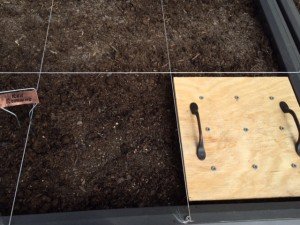
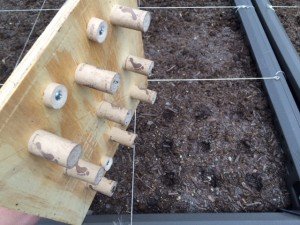 Lettuce can be planted 9 to a square foot so I pressed the spacer into 4 of my 1'x1' squares to leave divots where the seeds should be planted.Next I shook out some seed into my palm and placed 2 per divot. I normally have really good germination rates with the Baker Creek lettuce seeds, but these are last year's seeds so I did 2 to be safe. This was the most time intensive part of the whole operation but not what I would call laborious.
Lettuce can be planted 9 to a square foot so I pressed the spacer into 4 of my 1'x1' squares to leave divots where the seeds should be planted.Next I shook out some seed into my palm and placed 2 per divot. I normally have really good germination rates with the Baker Creek lettuce seeds, but these are last year's seeds so I did 2 to be safe. This was the most time intensive part of the whole operation but not what I would call laborious. When I was done I patted the soil over the seeds, lightly covering them and creating good dirt to seed contact then watered.
When I was done I patted the soil over the seeds, lightly covering them and creating good dirt to seed contact then watered.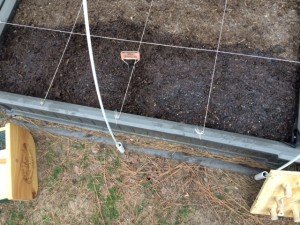 Voila!Yes there will be some watering throughout the season and yes, I do get an occasional volunteer plant that needs to be plucked out of my garden beds, but those are minor things, easily taken care of when I head out to my backyard grocery store each night and look around to see what's for dinner.
Voila!Yes there will be some watering throughout the season and yes, I do get an occasional volunteer plant that needs to be plucked out of my garden beds, but those are minor things, easily taken care of when I head out to my backyard grocery store each night and look around to see what's for dinner.
New Year's Resolutions (Then and Now)
For 2015 I set two gardening goals for myself - begin keeping a garden log and saving seed and I did pretty well on both of them. My 2015 garden log ended the year with 8 typed pages and containing details from pounds of tomatoes and serranos harvested to the date of the first and last blueberries. I used Word for Mac so I can keyword search in 2016 (and beyond) if I want to find when I planted the 3rd crop of edamame or when my squash and cucumbers were invaded by cucumber worms. I found I was more diligent about doing entries if I kept the document open on my second monitor at all times so when I began the 2016 garden log earlier this month detailing all the indoor starts for January, I continued with this practice.Prior to 2015, I had only saved my own cilantro/coriander seed and purchased everything else. At the end of 2015 I had saved 10 different varieties of everything from squash and chili peppers to flowers and tomatoes. My seed box, which has always been full of Baker Creek Heirloom Seeds packages is now peppered with the plain brown paper envelopes that I use for my own seed.For 2016 my two goals are saving even more of my own seed and mulching. Going from 1 to 10+ varieties that I saved seed from in 2015 is good, but I am growing over 53 annual varieties in 2016 so there is plenty of room to continue to improve in this goal.The Square Foot Gardening method I use places a heavy emphasis on compost but almost none on mulching. The SFG method recommends starting with a 33% compost mixture in the raised beds and continually adding compost as plants are removed and new plants added to each individual square foot, but no mention of covering the soil between and around plants. Soil science as well as observation have led me to understand that just as nature abhors a vacuum and will swiftly fill it, soil abhors being exposed and will cover itself with weeds if it must to protect it from the wind and the sun, allowing it to retain water better and reduce erosion.So for 2016 I will be experimenting with different types of mulches in my beds to see what works best, doesn't invite too many visiting pests and makes the plants and soil happy and healthy.Here's to getting better every year! #Kaizen
The Expat Starter Garden
A dear friend is moving south of the border to live on the shores of Lake Chapala, said to have the second best climate on earth, behind only Atenas, Costa Rica. She wants to start a small garden there and was looking for suggestions.All of these suggestions do very well in both containers (both patio and raised bed) and in rich garden soil, making them versatile, low maintenance choices for a first time gardener.If you are only going to grow one thing, I think basil is a great place to start. It is easy to grow, abundantly productive and can be added to almost every meal you make or have for takeout. I prefer the sweet genovese varieties.If you are only going to grow two things, then basil and cilantro are my choices. Again, easy, abundant and can add a bright taste to any dish, homemade or otherwise. For warmer climates (mine included) try a slo bolt variety.Oregano and rosemary are also low maintenance but useful and abundant herbs for a first time gardener and experienced cook.If she wants to expand beyond herbs, spinach is a great choice for novices. Leaves can be taken as needed allowing the plant to continue growing, many fresh or cooked uses and easy to grow. Again, with warmer climates, a slo bolt variety would be best.After spinach, the chili pepper of your preferred spiciness range. I favor serranos. They are very abundant producers, impart a great flavor in addition to the heat they add to dishes and can be picked green or red depending on your heat preferences. Roasting ripe ones each time you grill and freezing them means delicious roasted peppers on hand year round.And then every gardener's pride and joy, tomatoes. For many of the same reasons, I would recommend cherry type tomatoes for the small scale gardener. They produce much more abundantly than slicing tomato varieties and due to their size can be dried or roasted and frozen for year round additions to meals.With just these 7 items, incorporating bounty fresh from the garden (or preserved from the garden) year round is easy and will work into everyone's favorite dishes.
Countdown to Garden 2016
Even before presents are unwrapped, the countdown is on with less than a month to go before indoor starts of cabbage, leeks and rosemary get going in the first part of January with peppers (hot and bell) just behind.So I've been making my list and checking it twice this week to see what varieties will make it into my 219 square foot of garden space for 2016.I am making heavy use of containers for herbs (and one lettuce I just couldn't resist) and also using two composted trenches in the yard to grow The Three Sisters: corn, blackeyed peas and decorative squash. I currently have 8 1x1 boxes for cucurbits, but will be adding in 3 more before spring to hold all the zucchini, squash and cucumbers on my list.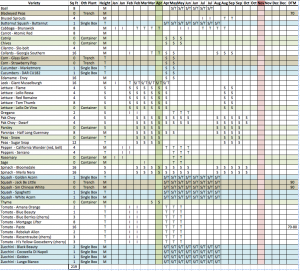 Despite planning 52 different varieties of annuals for next year, my 2016 seed order (including shipping) came in under $42. This economy was mostly due to saving more of my own seed this year than ever before and having plenty of unused 2015 seed for most of what I plan to grow next year - Square Foot Gardening makes better use of individual seeds than row gardening so more seeds are conserved for future use.
Despite planning 52 different varieties of annuals for next year, my 2016 seed order (including shipping) came in under $42. This economy was mostly due to saving more of my own seed this year than ever before and having plenty of unused 2015 seed for most of what I plan to grow next year - Square Foot Gardening makes better use of individual seeds than row gardening so more seeds are conserved for future use.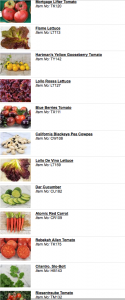 One of my splurge purchases for this year was the Slo-Bolt Cilantro. I am still drawing down the huge supply of cilantro/coriander seeds saved from my 2012 garden. They still have a high germination rate so I have been using them for both outdoor garden and microgreen plantings since then. If the slo-bolt lives up to its name, my 2012 cilantro has had its last reproductive cycle and will be only for microgreens and I will switch to saving the slo-bolt seed.Next I will start plotting out the placement of these plantings on my garden map. 2015 was my first full garden cycle in Raleigh and the biggest lesson was that maximizing light has to be a priority for north facing gardens further complicated by some tree shade. To that end, I added a height column with each plant ranked Short, Medium or Tall to plan my garden for next year. Tallest plants in to the north and shortest plants to the south has always been the rule of thumb but is now a requirement for my future garden plans which will make crop rotations a little more challenging.It is damp, but in the low-mid 70's this weekend, so I will also spend some time putting in new grids into my raised beds. I have been using kitchen string for the past few years but the cottony string only lasts one year before stretching, breaking and needing to be replaced. This year I am going to try a white nylon string that is made for outdoor use and hope it holds up better.Here's to a wonderful close to 2015 and a bright start to 2016! Happy Holidays!
One of my splurge purchases for this year was the Slo-Bolt Cilantro. I am still drawing down the huge supply of cilantro/coriander seeds saved from my 2012 garden. They still have a high germination rate so I have been using them for both outdoor garden and microgreen plantings since then. If the slo-bolt lives up to its name, my 2012 cilantro has had its last reproductive cycle and will be only for microgreens and I will switch to saving the slo-bolt seed.Next I will start plotting out the placement of these plantings on my garden map. 2015 was my first full garden cycle in Raleigh and the biggest lesson was that maximizing light has to be a priority for north facing gardens further complicated by some tree shade. To that end, I added a height column with each plant ranked Short, Medium or Tall to plan my garden for next year. Tallest plants in to the north and shortest plants to the south has always been the rule of thumb but is now a requirement for my future garden plans which will make crop rotations a little more challenging.It is damp, but in the low-mid 70's this weekend, so I will also spend some time putting in new grids into my raised beds. I have been using kitchen string for the past few years but the cottony string only lasts one year before stretching, breaking and needing to be replaced. This year I am going to try a white nylon string that is made for outdoor use and hope it holds up better.Here's to a wonderful close to 2015 and a bright start to 2016! Happy Holidays!
Favorite Things
One of my favorite gifts to give the bookworms on my holiday shopping list this year are these wonderful little bookmarks from GreenMarker.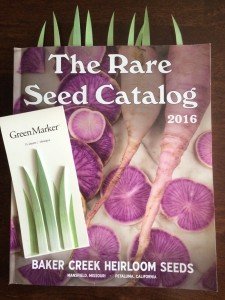 There are 75 blades in each pack so I might have enough to do my whole spring seed order ;)
There are 75 blades in each pack so I might have enough to do my whole spring seed order ;)
Glass Gem Corn
 It's not often that a packet of seeds is so exciting that I cannot wait until spring to open the flap and take a peek inside. Glass Gem corn is a clear exception!The Glass Gem heirloom corn variety hit the homegrown stage a few years ago and has been offered only on a wait-list basis from very limited outlets until now. So when I saw the cover of the 2016 Baker Creek Heirloom Seeds catalog I assumed they were just highlighting a very photogenic variety for the cover. When I discovered they were actually carrying the seed, I didn't hesitate and am now planning where to plant the star of my 2016 garden!
It's not often that a packet of seeds is so exciting that I cannot wait until spring to open the flap and take a peek inside. Glass Gem corn is a clear exception!The Glass Gem heirloom corn variety hit the homegrown stage a few years ago and has been offered only on a wait-list basis from very limited outlets until now. So when I saw the cover of the 2016 Baker Creek Heirloom Seeds catalog I assumed they were just highlighting a very photogenic variety for the cover. When I discovered they were actually carrying the seed, I didn't hesitate and am now planning where to plant the star of my 2016 garden!











